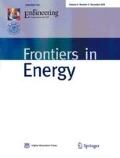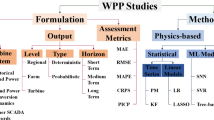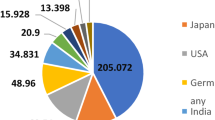Abstract
Unlike the traditional fossil energy, wind, as the clean renewable energy, can reduce the emission of the greenhouse gas. To take full advantage of the environmental benefits of wind energy, wind power forecasting has to be studied to overcome the troubles brought by the variable nature of wind. Power forecasting for regional wind farm groups is the problem that many power system operators care about. The high-dimensional feature sets with redundant information are frequently encountered when dealing with this problem. In this paper, two kinds of feature set construction methods are proposed which can achieve the proper feature set either by selecting the subsets or by transforming the original variables with specific combinations. The former method selects the subset according to the criterion of minimal-redundancy-maximal-relevance (mRMR), while the latter does so based on the method of principal component analysis (PCA). A locally weighted learning method is also proposed to utilize the processed feature set to produce the power forecast results. The proposed model is simple and easy to use with parameters optimized automatically. Finally, a case study of 28 wind farms in East China is provided to verify the effectiveness of the proposed method.
Similar content being viewed by others
References
Xinhua Net. China-U.S. joint presidential statement on climate change. 2017–1-12, http://news.xinhuanet.com/world/2015-09/26/c_1116685873.htm.
Pinson P, Chevallier C, Kariniotakis G N. Trading wind generation from short-term probabilistic forecasts of wind power. IEEE Transactions on Power Systems, 2007, 22(3): 1148–1156
Botterud A, Zhou Z, Wang J, Bessa R J, Keko H, Sumaili J, Miranda V. Wind power trading under uncertainty in LMP markets. IEEE Transactions on Power Systems, 2012, 27(2): 894–903
González-Aparicio I, Zucker A. Impact of wind power uncertainty forecasting on the market integration of wind energy in Spain. Applied Energy, 2015, 159: 334–349
Makarov Y V, Etingov P V, Ma J, Huang Z, Subbarao K. Incorporating uncertainty of wind power generation forecast into power system operation, dispatch, and unit commitment procedures. IEEE Transactions on Sustainable Energy, 2011, 2(4): 433–442
Botterud A, Zhou Z, Wang J, Sumaili J, Keko H, Mendes J, Bessa R J, Miranda V. Demand dispatch and probabilistic wind power forecasting in unit commitment and economic dispatch: a case study of Illinois. IEEE Transactions on Sustainable Energy, 2013, 4(1): 250–261
Bessa R J, Matos M A, Costa I C, Bremermann L, Franchin I G, Pestana R, Machado N, Waldl H, Wichmann C. Reserve setting and steady-state security assessment using wind power uncertainty forecast: a case study. IEEE Transactions on Sustainable Energy, 2012, 3(4): 827–836
Menemenlis N, Huneault M, Robitaille A. Computation of dynamic operating balancing reserve for wind power integration for the timehorizon 1–48 hours. IEEE Transactions on Sustainable Energy, 2012, 3(4): 692–702
Pinson P, Papaefthymiou G, Klöckl B, Verboomen J. Dynamic sizing of energy storage for hedging wind power forecast uncertainty. In: Proceedings of PESGM 2009. Alberta: IEEE, 2009, 1760–1768
Bludszuweit H, Domínguez-Navarro J A. A probabilistic method for energy storage sizing based on wind power forecast uncertainty. IEEE Transactions on Power Systems, 2011, 26(3): 1651–1658
Global Wind Energy Council. Global wind report 2015. Brussels, Belgium, 2016, 9–10
Focken U, Lange M, Mönnich K, Waldl H P, Beyer H G, Luig A. Short-term prediction of the aggregated power output of wind farms—a statistical analysis of the reduction of the prediction error by spatial smoothing effects. Journal of Wind Engineering and Industrial Aerodynamics, 2002, 90(3): 231–246
Monteiro C, Bessa R, Miranda V, Botterud A, Wang J, Conzelmann G, Porto I. Wind power forecasting: state-of-the-art 2009. Office of Scientific & Technical Information Technical Reports, 2009, https://digital.library.unt.edu/ark:/67531/metadc930905/
Lobo M G, Sanchez I. Regional wind power forecasting based on smoothing techniques, with application to the spanish peninsular system. IEEE Transactions on Power Systems, 2012, 27(4): 1990–1997
Siebert N. Development of methods for regional wind power forecasting. Dissertation for the Doctoral Degree. Paris: ENSMP (École Nationale Supérieure des Mines de Paris), 2008, 127–189
Davò F, Alessandrini S, Sperati S, Delle Monache L, Airoldi D, Vespucci M T. Post-processing techniques and principal component analysis for regional wind power and solar irradiance forecasting. Solar Energy, 2016, 134: 327–338
Li P, Guan X, Wu J. Aggregated wind power generation probabilistic forecasting based on particle filter. Energy Conversion and Management, 2015, 96: 579–587
Peng H, Long F, Ding C. Feature selection based on mutual information criteria of max-dependency, max-relevance, and minredundancy. IEEE Transactions on Pattern Analysis and Machine Intelligence, 2005, 27(8): 1226–1238
Genest C, Favre A. Everything you always wanted to know about copula modeling but were afraid to ask. Journal of Hydrologic Engineering, 2007, 12(4): 347–368
Jolliffe I T. Principal Component Analysis. Berlin: Springer, 1986, 111–147
Atkeson C G, Moore A W, Schaal S. Locally weighted learning. In: Aha D W. ed. Lazy Learning. Dordrecht: Springer Netherlands, 1997, 11–73
Freidman J H, Bentley J L, Finkel R A. An algorithm for finding best matches in logarithmic expected time. ACM Transactions on Mathematical Software, 1977, 3(3): 209–226
Lagarias J C, Wright M H, Wright P E, Reeds J A. Convergence properties of the Nelder-Mead simplex method in low dimensions. Siam Journal on Optimization A Publication of the Society for Industrial & Applied Mathematics, 1998, 9(1): 112–147
Acknowledgements
This project was supported by the National Natural Science Foundation of China (Grant No. 51477156) and Science & Technology Foundation of SGCC (No. NY7116021).
Author information
Authors and Affiliations
Corresponding author
Rights and permissions
About this article
Cite this article
Wang, Z., Wang, W. & Wang, B. Regional wind power forecasting model with NWP grid data optimized. Front. Energy 11, 175–183 (2017). https://doi.org/10.1007/s11708-017-0471-9
Received:
Accepted:
Published:
Issue Date:
DOI: https://doi.org/10.1007/s11708-017-0471-9




